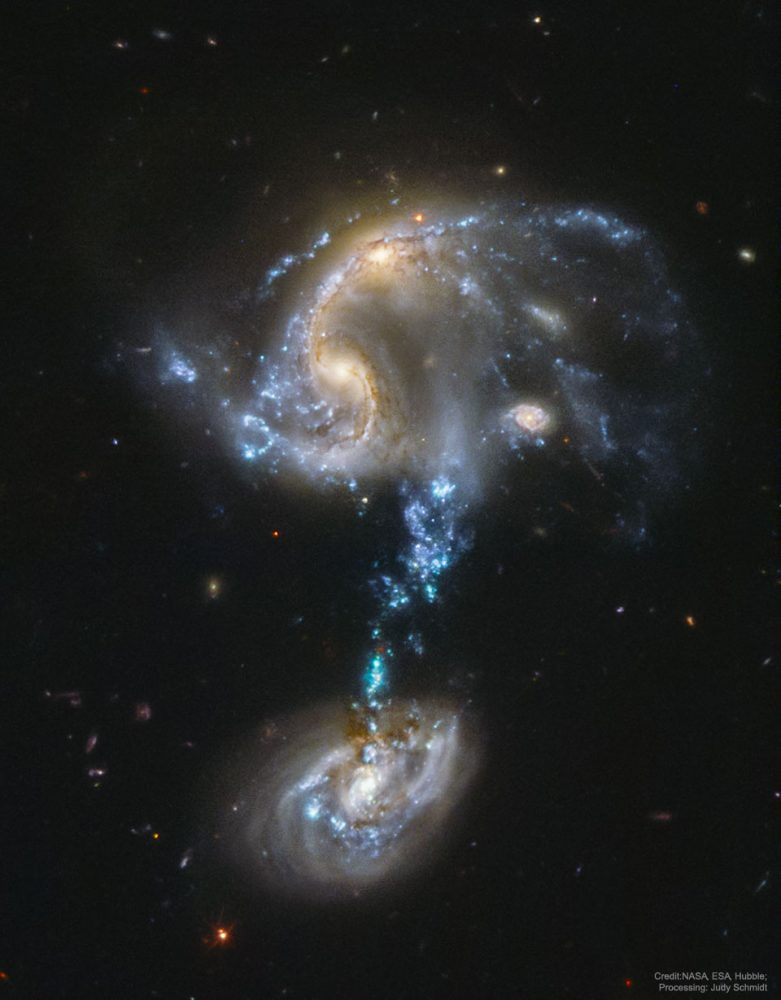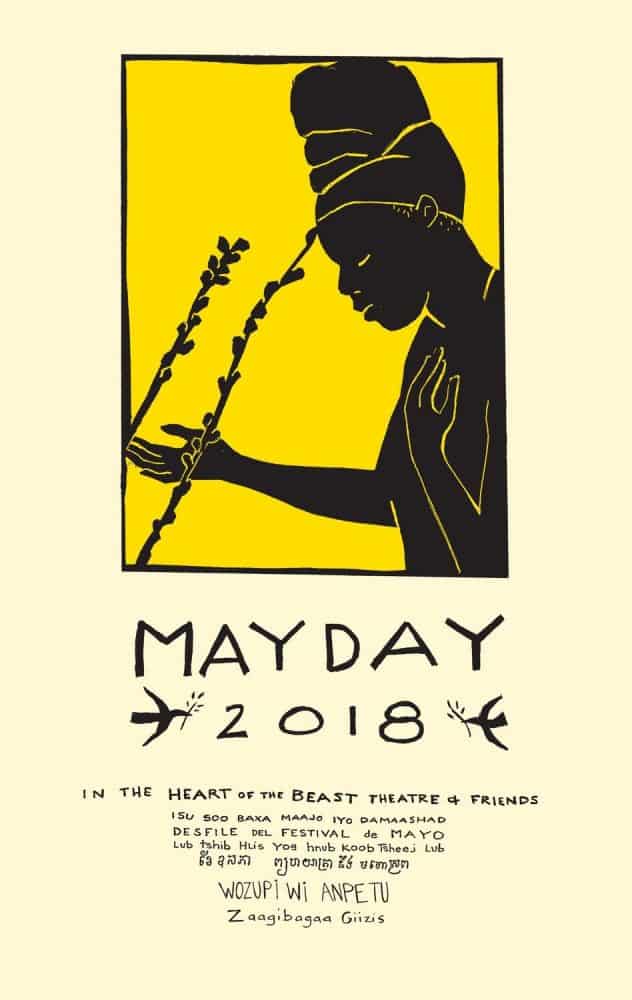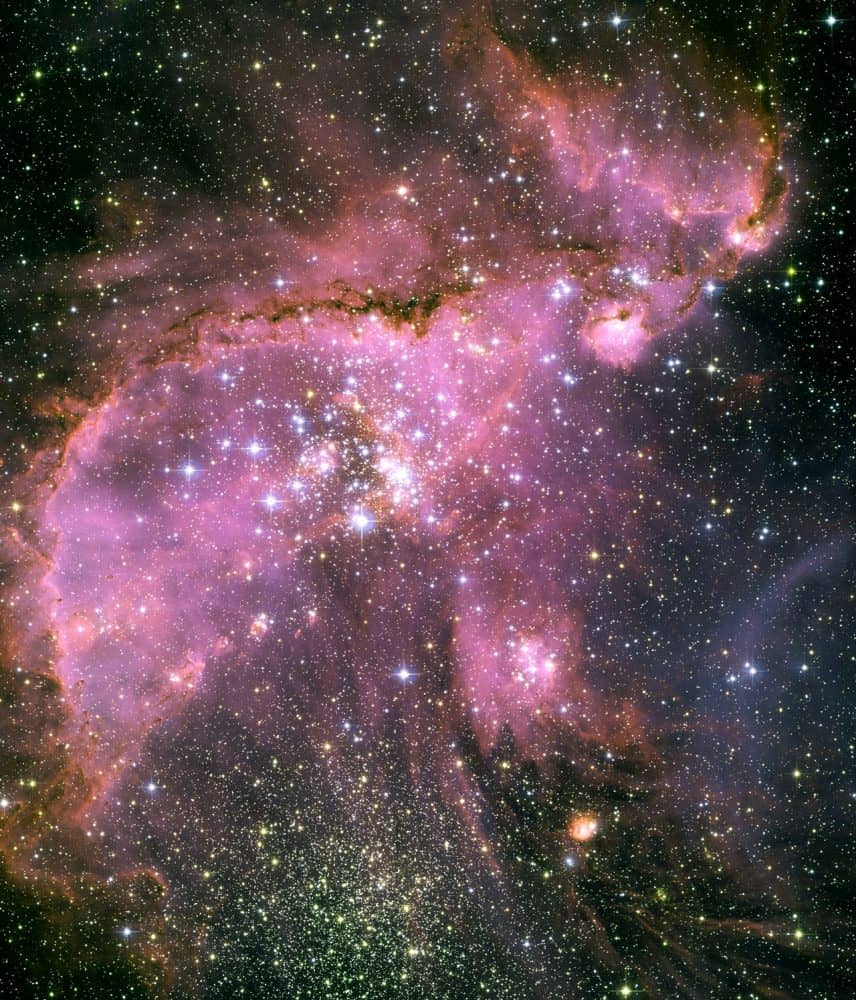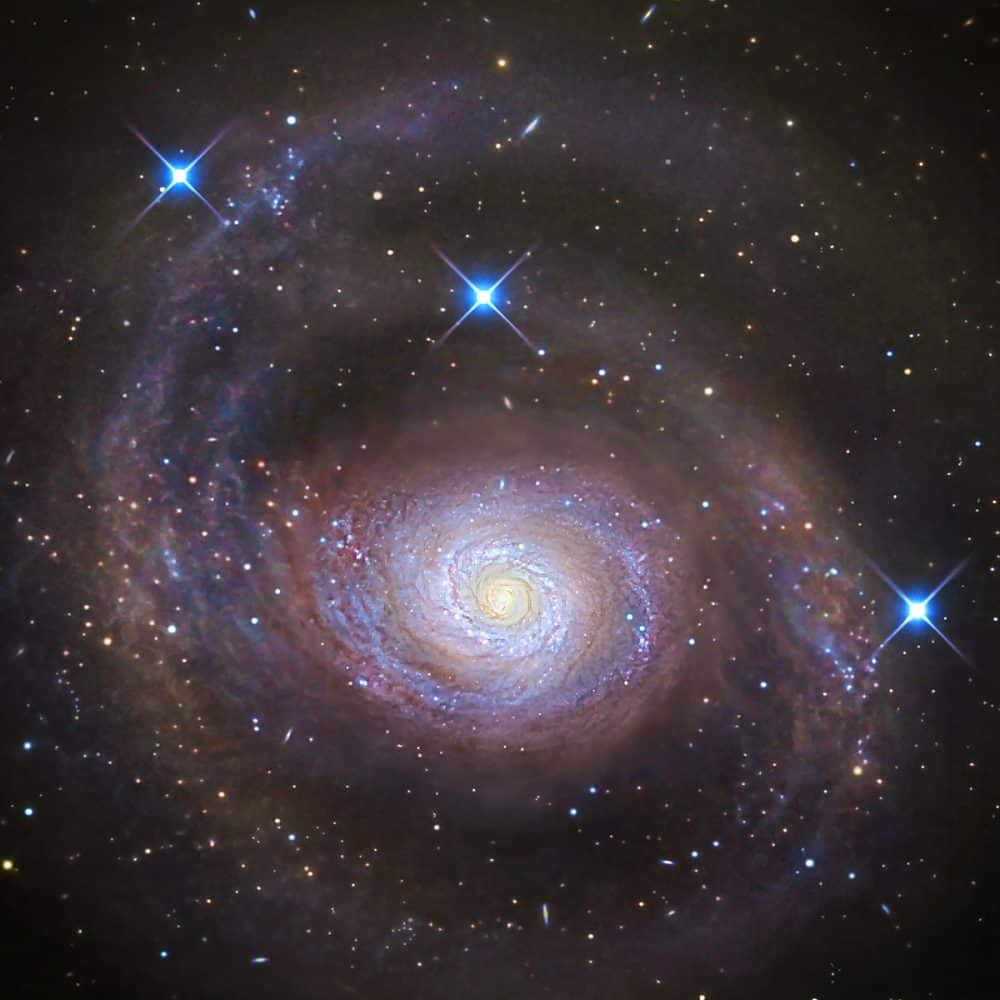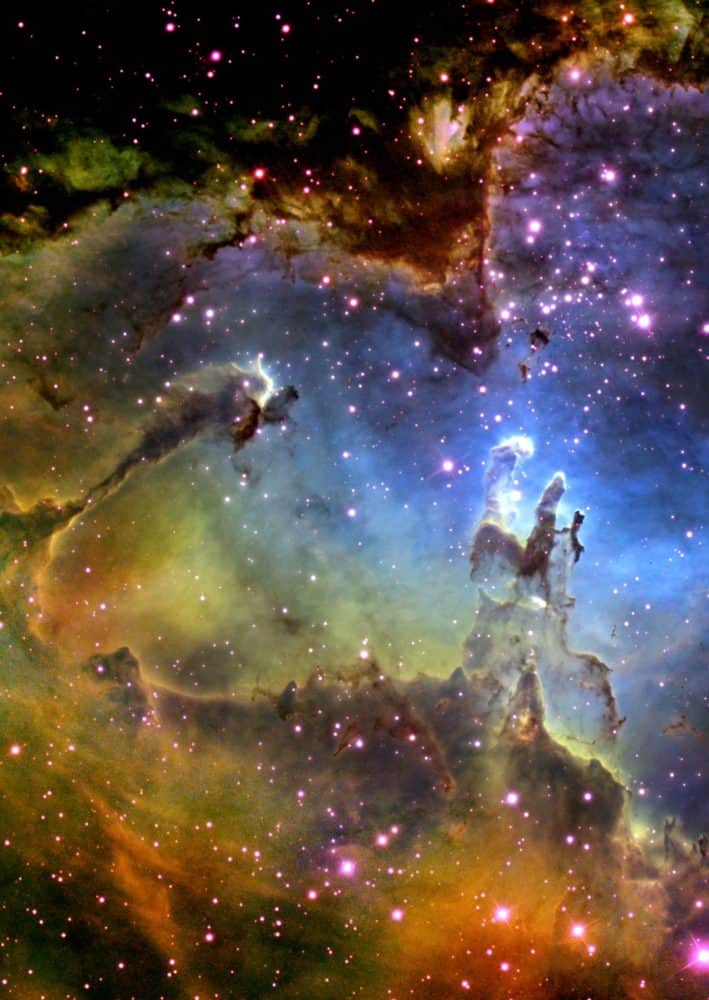Blog
Why are stars forming in the bridge between these colliding galaxies? Usually when galaxies crash, star formation is confined to galaxy disks or tidal tails. In Arp 194, though, there are bright knots of young stars right in a connecting bridge. Analyses of images and data including the featured image of Arp 194 from Hubble, as well as computer simulations of the interaction, indicate that the bottom galaxy passed right through the top galaxy within the past 100 million years. The result has left a stream of gas that is now falling toward the bottom galaxy. Astronomers hypothesize that stars form in this bridge because of the recent fading of turbulence after the rapid collision. In about a billion years, the galaxies — including a smaller galaxy superposed on the upper galaxy (see it?) — will all merge into one larger galaxy.
more...Stephen Paul Motian (March 25, 1931 – November 22, 2011) was an American jazz drummer, percussionist, and composer. Motian played an important role in freeing jazz drummers from strict time-keeping duties.
He first came to prominence in the late 1950s in the piano trio of Bill Evans, and later was a regular in pianist Keith Jarrett‘s band for about a decade (c. 1967–1976). Motian began his career as a bandleader in the early 1970s. Perhaps his two most notable groups were a longstanding trio of guitarist Bill Frisell and saxophonist Joe Lovano, and the Electric Bebop Band which featured the drummer working mostly with younger musicians doing interpretations of bebop standards.
Motian was born in Philadelphia, Pennsylvania, and raised in Providence, Rhode Island. He is of Armenian descent. After playing guitar in his childhood, Motian began playing the drums at age 12, eventually touring New England in a swing band. During the Korean War he joined the Navy.
Motian became a professional musician in 1954, and briefly played with pianist Thelonious Monk. He became well known as the drummer in pianist Bill Evans‘s trio (1959–64), initially alongside bassist Scott LaFaro and later with Chuck Israels.
Subsequently, he played with pianists Paul Bley (1963–64) and Keith Jarrett (1967–76). Other musicians with whom Motian performed and/or recorded in the early period of his career included Lennie Tristano, Warne Marsh, Lee Konitz, Joe Castro, Arlo Guthrie (Motian performed briefly with Guthrie in 1968–69, including at Woodstock), Carla Bley, Charlie Haden, and Don Cherry. Motian subsequently worked with musicians such as Marilyn Crispell, Bill Frisell, Leni Stern, Joe Lovano, Gonzalo Rubalcaba, Alan Pasqua, Bill McHenry, Stéphan Oliva, Frank Kimbrough, Eric Watson and many more.
more...Cecil Percival Taylor (March 15, 1929 – April 5, 2018) was an American pianist and poet.
Taylor was classically trained and was one of the pioneers of free jazz. His music is characterized by an energetic, physical approach, resulting in complex improvisation often involving tone clusters and intricate polyrhythms. His technique has been compared to percussion. Referring to the number of keys on a standard piano, Val Wilmer used the phrase “eighty-eight tuned drums” to describe Taylor’s style. He has been referred to as being “like Art Tatum with contemporary-classical leanings”.
Taylor was raised in the Corona, Queens neighborhood of New York City. As an only child to a middle-class family, Taylor’s mother encouraged him to play music at an early age. He began playing piano at age six and went on to study at the New York College of Music and New England Conservatory in Boston. At the New England Conservatory, Taylor majored in composition and arranging. During his time there, he also became familiar with contemporary European art music. Bela Bartók and Karlheinz Stockhausen notably influenced his music.
In 1955, Taylor moved back to New York City from Boston. He formed a quartet with soprano saxophonist, Steve Lacy, bassist Buell Neidlinger, and drummer Dennis Charles. Taylor’s first recording, Jazz Advance, featured Lacy and was released in 1956. The recording is described by Richard Cook and Brian Morton in the Penguin Guide to Jazz: “While there are still many nods to conventional post-bop form in this set, it already points to the freedoms in which the pianist would later immerse himself.” Taylor’s quartet featuring Lacy also appeared at the 1957 Newport Jazz Festival, which was made into the album At Newport. Taylor collaborated with saxophonist John Coltrane in 1958 on Stereo Drive, now available as Coltrane Time.
more...Mauritania
more...As you have probably heard this years 45th Annual Mayday Parade, Ceremony and Festival has had substantial budget cuts. As a result there will only be one area with a SOUND SYSTEM this year. And that will be at the Ceremony Site on the lakeshore at the bottom of the hill (west side of park).
I have been invited to have access to the sound system so at this time and date, I will have POSITIVE VIBRATIONS (reggae) and the BEAU KOO JACKS (Mardi Gras) performing directly after the Ceremony. We will be ground level on the grass and the crowd will be dancing wildly in front of us. Yiiiiiipeeee!
more...
This Hubble Space Telescope view shows one of the most dynamic and intricately detailed star-forming regions in space, located 210,000 light-years away in the Small Magellanic Cloud (SMC), a satellite galaxy of our Milky Way. At the centre of the region is a brilliant star cluster called NGC 346. A dramatic structure of arched, ragged filaments with a distinct ridge surrounds the cluster.
A torrent of radiation from the hot stars in the cluster NGC 346, at the centre of this Hubble image, eats into denser areas around it, creating a fantasy sculpture of dust and gas. The dark, intricately beaded edge of the ridge, seen in silhouette, is particularly dramatic. It contains several small dust globules that point back towards the central cluster, like windsocks caught in a gale.
more...Lee Oskar (born 24 March 1948, Copenhagen, Denmark) is a Danish harmonica player, notable for his contributions to the sound of the rock-funk fusion group War, which he formed with Eric Burdon, his solo work, and as a harmonica manufacturer. He currently plays with 3 other original WAR band members, Harold Brown, Howard Scott and B.B. Dickerson, under the name LowRider Band. Born in Copenhagen, Denmark in 1948, Oskar was six years old when a family friend gave him his first harmonica. “I came from an area where every kid on the block had a harmonica”, he remembers. He grew up listening to Danish radio, enjoying all types of music and cites Ray Charles as the biggest influence from that period. When he was 17, Oskar decided that the United States was where a harmonica player should make his career. So he moved to New York at the age of 18 with little more than a harmonica in his pocket. With no money, Oskar played harmonica in the streets of New York. Eventually arriving in Los Angeles, via Toronto and San Francisco, Oskar soon met and joined forces with Eric Burdon who had recently disbanded The Animals and was searching for new collaborators. Together, the harmonica-playing Dane (born Lee Oskar Levitin) and the British blues-rock singer made the rounds of the L.A. clubs, eventually hooking up with the soon-to-be members of War. Burdon agreed to the novel idea of pairing up Oskar’s harmonica with Charles Miller‘s saxophone to form a horn section. This team-up set War apart from the start, giving Oskar room to display the full spectrum of his improvisational prowess. Oskar’s harmonica magic was always a vital element in War’s music and performances. Oskar continued with War for 24 years non-stop. At the end of 1992, during the time of dispute over the WAR trademark, Oskar took a few years to continue his solo career and to focus on his Lee Oskar Harmonica manufacturing.
https://www.youtube.com/watch?v=zvSu2xZYzK8
Paul Brownlee McCandless Jr. (born March 24, 1947 in Indiana, Pennsylvania) is an American multi-instrumentalist and founding member of the American jazz group Oregon. He is one of few expert jazz oboists. He also plays bass clarinet, English horn, and soprano saxophone.
McCandless has released a series of records of his own compositions with bands he led, including All the Mornings Bring (Elektra/Asylum, 1978), Heresay (Windham Hill, 1988), Navigator(Landslide, 1981), and Premonition (Windham Hill, 1992). With Oregon, he has recorded over twenty albums albums with Paul Winter.
In 1996, McCandless won a Grammy Award for Best Pop Instrumental with Béla Fleck and the Flecktones. He also won Grammys in 2007 and 2011 with the Paul Winter Consort for Best New Age Album and in 1993 for Al Jarreau‘s album Heaven and Earth. His performance on Oregon’s album 1000 Kilometers was nominated for a Grammy for Best Jazz Instrumental Solo in 2009. He won the Down Beat Critics’ Poll for Best Established Combo, the Deutscher Schallplatten Preis for his album Ectopia, and the Arbeitskreis Jazz im Bundesverband der Phonographishen Wirtschaft Gold Record Award.
more...King Pleasure (March 24, 1922 – March 21, 1982) was a jazz vocalist and an early master of vocalese, where a singer sings words to a famous instrumental solo.
Pleasure has been cited as a significant influence by Van Morrison, especially on his album Astral Weeks. Genya Ravan, drawing big inspiration for her singing from King Pleasure, recorded “Moody’s Mood For Love” with James Moodyon her 1972 CBS album Genya Ravan.
Pleasure died on March 21, 1982, 3 days before his 60th birthday.
more...Beautiful spiral galaxy M94 (Messier 94) lies a mere 15 million light-years distant in the northern constellation of the hunting dogs, Canes Venatici. A popular target for astronomers, the brighter inner part of the face-on galaxy is about 30,000 light-years across. Traditionally, deep images have been interpreted as showing M94’s inner spiral region surrounded by a faint, broad ring of stars. But a new multi-wavelength investigation has revealed previously undetected spiral arms sweeping across the outskirts of the galaxy’s disk, an outer disk actively engaged in star formation. At optical wavelengths, M94’s outer spiral arms are followed in this remarkable discovery image, processed to enhance the outer disk structure. Background galaxies are visible through the faint outer arms, while the three spiky foreground stars are in our own Milky Way galaxy.
more...Yvette Marie Stevens (born March 23, 1953), better known by her stage name Chaka Khan, is an American musician, singer and songwriter. Her career has spanned nearly five decades, beginning in the 1970s as the lead vocalist of the funk band Rufus. Khan received public attention for her vocals and image. Known as the Queen of Funk, Khan was the first R&B artist to have a crossover hit featuring a rapper, with “I Feel for You” in 1984. Khan has won ten Grammys and has sold an estimated 70 million records worldwide.
In the course of her solo career, Khan has achieved three gold singles, three gold albums and one platinum album with I Feel for You. With Rufus, she achieved four gold singles, four gold albums, and two platinum albums. She has collaborated with Ry Cooder, Robert Palmer, Ray Charles, Quincy Jones, Guru, Chicago, and Mary J. Blige, among others. In December 2016, Billboard magazine ranked her as the 65th most successful dance artist of all time. She was ranked at number 17 in VH1‘s original list of the 100 Greatest Women of Rock & Roll. She has been nominated for induction into the Rock and Roll Hall of Fame twice; she was first nominated as member of Rufus in 2011.
Chaka Khan was born Yvette Marie Stevens on March 23, 1953 into an artistic, bohemian household in Chicago, Illinois. The eldest of five children born to Charles Stevens and Sandra Coleman, she has described her father as a beatnik and her mother as “able to do anything.
https://www.youtube.com/watch?v=6NIt3Kot8Ws
more...John Albert “Johnny” Guarnieri (March 23, 1917 – January 7, 1985) was an American jazz and stride pianist, born in New York City.
Guarnieri joined the George Hall orchestra in 1937. He is perhaps best known for his big band stints with Benny Goodman in 1939 and with Artie Shaw in 1940. Guarnieri is also noted for his embellishment and juxtaposition of jazz with classical piano, such as Scarlatti and Beethoven.
Throughout the 1940s Guarnieri was a busy sideman, recording with artists such as Charlie Christian, Cozy Cole, Ike Quebec, Charlie Kennedy, Hank D’Amico and Ben Webster. He also led his own group called the “Johnny Guarnieri Swing Men” and recorded with them on the Savoy label, a group that included Lester Young, Hank D’Amico, Billy Butterfield and Cozy Cole. He also led a trio in the 1940s composed of himself, Slam Stewart and Sammy Weiss, recording again for Savoy. During the 1940s he also recorded for the short-lived Majestic label, playing solo piano and with his trio.
https://www.youtube.com/watch?v=SgBAV0qLDMk
more...Iverson Minter (March 23, 1932 – February 25, 2012), known as Louisiana Red, was an African-American blues guitarist, harmonica player, and singer, who recorded more than 50 albums. He was best known for his song “Sweet Blood Call“.
After leaving the Army, he played with John Lee Hooker in Detroit for two years in the late 1950s. He recorded for Checker Records in 1952, billed as Rocky Fuller.
His first album, Lowdown Back Porch Blues, was recorded in New York with Tommy Tucker and released in 1963. His second album, Seventh Son, was released later the same year. Louisiana Red released the single “I’m Too Poor to Die” for the Glover label in 1964. It peaked at number 117 on the Billboard Hot 100 and number 30 on the Cashbox chart. (Billboard did not publish an R&B chart in 1964.)
more...
IC 4703 is the diffuse emission nebula or HII region associated with Messier 16, which is actually a cluster of stars. It is the nebulous region surrounding Messier 16. These two objects make up the Eagle Nebula. They are relatively bright and are located in the constellation Serpens Cauda. This region contains the picturesque Pillars of Creation. This is an active star forming region 7,000 light years away. It is approximately magnitude 8. The cluster was discovered by De Cheseaux, but Messier later rediscovered it and remarked on its apparent nebulous appearance. The cluster is estimated to be 5.5 million years old, and the nebula would be a bit older. The nebula is about 55 x 70 light years. The Eagle Nebula lies in the Sagittarius Arm of the Milky Way.
more...More Posts
- Daily Roots with Coco Tea
- Surviving the Pandemic and Realizing Racial Justice
- The Cosmos with NGC 6300
- McCoy Tyner
- Big Mama Thornton
- Pérez Prado
- Carlos Gardel
- Flamenco Fridays with Las Migas
- Daily Roots with the Cimarons
- Surviving the Pandemic and Realizing Racial Justice
- The Cosmos with Simeis 147
- Ismail “Pops” Mohamed
- Guitar Slim
- Bob Cranshaw
- Ray Nance
- World Music with Rodrigo Serrão
- Daily Roots with Cornel Campbell
- Surviving the Pandemic and Realizing Racial Justice
- The Cosmos with NGC 1792
- Dan Hicks
